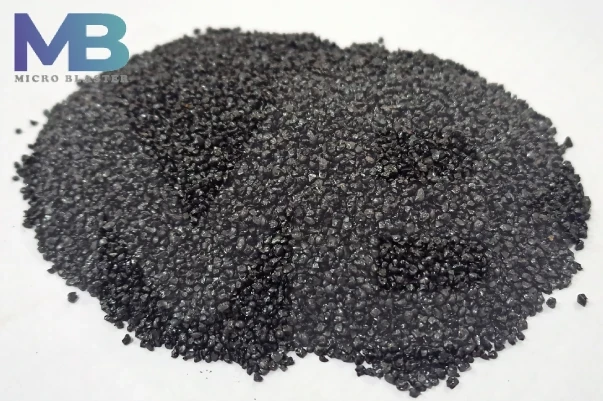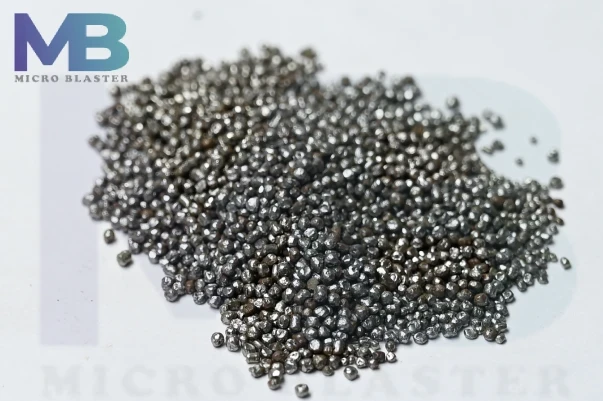Introduction Of Polyester Blasting Media
Polyester blasting media, also known as polyester abrasive media, is a type of plastic abrasive media used in abrasive blasting processes. It consists of polyester-based plastic particles that come in various shapes, sizes, and degrees of hardness. Polyester media is a popular choice for certain blasting applications due to its specific properties and benefits.
Polyester plastic blasting media is an excellent choice for sand blasting machine operations that requires a gentle touch. It is especially useful in industries where preserving the integrity of the substrate is crucial, such as aerospace, electronics, and automotive. Its properties allow for effective cleaning, preparation, and finishing without the risk of damaging delicate surfaces.
Properties of Polyester Blasting Media
- Material Composition: Polyester blasting media is assembled from polyester resin, a type of synthetic polymer. The material is durable, lightweight, and can be manufactured in a range of hardness levels.
- Shape and Size: Polyester media can come in various shapes, including angular, cylindrical, and spherical. The size of the media can vary from very fine particles to larger granules, turning on the application.
- Hardness: Polyester media is softer than many traditional abrasives like aluminum oxide or silicon carbide. This makes it suitable for applications where minimal substrate damage is required.
- Non-Metallic: Being non-metallic, polyester media does not spark, making it safe for use in environments where flammable materials are present.
- Reusability: Polyester media can often be reused multiple times, depending on the specific application and the condition of the media after use.
Types of Polyester Blasting Media
The plastic media blasting industry has evolved significantly over the years. Initially, three types of plastic media, all thermosets: Type I (Polyester), Type II (Urea formaldehyde), and Type III (Melamine formaldehyde).
Type I Polyester Blasting Media
Type I, the softest of the plastic media, was first developed from unfilled polyester. It is employed on considerable delicate substrates, like cleaning printed circuit boards in electronics and terminating thermal spray coatings from composites in aerospace. However, it was not sufficiently efficient for large-scale paint removal on current coatings, leading to the consequence of additional materials.
Type II Polyester Blasting Media
Type II, made from urea formaldehyde, became a widely used material due to its productivity also durability. It was strengthened with alpha cellulose fiber, making it effective for rapidly extracting thermal spray coatings. This media was extensively employed in aerospace for stripping paint from aircraft, as well as for cleaning and maintaining various elements. It is also employed further by aerospace in manufacturing processes also for cleaning durable aluminum and steel components.
Type III Polyester Blasting Media
Type III, made from melamine formaldehyde, is harder than Type II with a hardness of 4.0 on the Mohs scale. It is employed for extracting tough coatings and abrasive blasting machine operation and cleaning hard surfaces, especially in applications with more aggressive media. It is also used in the IC industry for deflating.
Type IV Polyester Blasting Media
Type IV, made from phenol formaldehyde, was not widely adopted. The subsequent material, an elevated molecular weight cast acrylic (Type V), became more popular.
Type V Polyester Blasting Media
Type V, made from cast acrylic, keeps a hardness of 3.0 and is less dense than other types. It is durable and generally employed for removing topcoats from thin aluminum components. It is less aggressive or less effective at eliminating primers, making it ideal for delicate work.
Type VI Polyester Blasting Media
Type VI, made from poly all yl glycol carbonate, is more intense than Type I but still safe for most substrates, specifically composites. It is effective at removing coatings, even those that were previously hard to extract without damaging the substrate.
These various varieties of polyester blasting media are chosen based on the specific requirements of the surface to be treated and the kind of material existing removed.
Advantages of Polyester Blasting Media
- Surface Protection: Because it is softer than many other abrasives, polyester media minimizes the risk of damaging or etching the substrate, making it ideal for delicate surfaces.
- Dust-Free: Polyester plastic blasting media tends to produce less dust compared to traditional mineral abrasives, resulting in a cleaner working environment and reduced need for dust collectors.
- Non-Sparking: Safe for use in environments with flammable materials, as it does not produce sparks.
- Versatility: Suitable for a wide range of materials, including metals, plastics, composites, and even some types of wood.
- Cost-Effective: Although polyester media may be more expensive than some other types of abrasives, its reusability and gentle action can make it cost-effective in the long run.
Polyester Blasting Media Manufacturers
We are the best polyester blasting media manufacturers in India and suppliers of polyester plastic blasting media. The price of our polyester blasting media varies based on the size and grade, but we offer lower prices compared to other industries. Micro Blaster provides a wide range of abrasive media, including aluminum oxide, copper slag, silicon carbide, steel shot, steel grit, tungsten carbide grit, glass beads, PS balls, ceramic beads, cut wire shot, and more.










